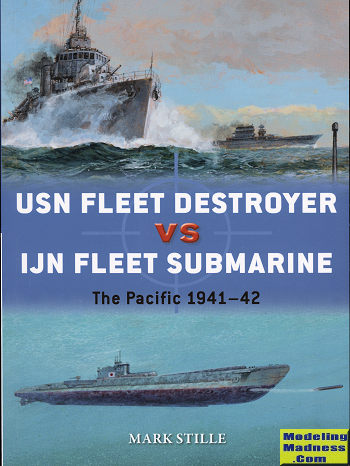 World War I
showed that the greatest threat to trans-ocean logistics was the submarine. The
Germans had developed submarine warfare into something that was quite
devastating and while the Allies were able to somewhat mitigate the threat, it
was really the lack of numbers that prevented the U-boat from really changing
the tide of the war.
World War I
showed that the greatest threat to trans-ocean logistics was the submarine. The
Germans had developed submarine warfare into something that was quite
devastating and while the Allies were able to somewhat mitigate the threat, it
was really the lack of numbers that prevented the U-boat from really changing
the tide of the war.
The Japanese were not ignorant of this aspect of naval
warfare and their post WWI submarines were of German design. However, the
Japanese realized that they had a considerably larger amount of water to cover
so they developed much larger cruiser submarines. The main job of these boats
was to operate in concert with the fleet, providing advance reconnaissance and
special operations. Sinking transports was not the primary focus. So their
submarine development focused on coastal defense and very large ocean going
types that often carried a seaplane.
Meanwhile, the US was developing destroyers that
initially fell into the restrictions of the various naval treaties and while
anti-submarine warfare was a consideration, these ships were multi-purpose in
terms of small ship actions and fleet defense. Their high speed was designed to
allow them to dash into the fray, loose a spread of torpedoes, and scurry away.
The beginning of the Pacific War was a bit of an
eye-opener for the Japanese. Their submarines were not very effective in the
roles for which they had been designed. When the boats were sent out on missions
to destroy transports along the US west coast and in the Indian Ocean, they had
some success, but it was the lack of aggressiveness as much as anything else
that produced disappointing results.
However, they were quite successful against US warships.
Indeed, they managed to sink or otherwise put out of action every US aircraft
carrier save one during all of 1942. Not only that, but no attacking submarine
was ever sunk. The majority of destroyed Japanese subs were caught on the
surface by airpower and not by destroyers.
US destroyers were pretty inept at their ability to find
and sink Japanese submarines. This was despite having probably the best
electronic system available. It is really luck as much as anything else that
kept the Japanese submarine from wreaking havoc with transports. This is because
the Japanese Navy kept using their submarines as transports during the various
campaigns, a job for which they were not designed and for which they could carry
very little. They were also tasked with all sorts of fairly unsuccessful special
missions with things like midget submarines when they should have been out
sinking cargo ships. As much as anything else, this misuse of assets doomed the
IJN submarine force, when it could have made a huge impact in the first year of
the war.
As is the norm with this series, the authors provide a
bit of background history to the two types as well as a look at how the crews
were trained and how the vessels were planned on being used. A goodly portion of
the book covers their combat experiences and pretty well dispenses with the myth
of the Japanese submarine being ineffective during this time. It was the I-19
that fired the most destructive torpedo spread ever. In September 1942 it fired
six torpedoes at the USS Wasp, sinking here. Those that missed went several
additional miles and sank the USS O'Brien and severely damaged the USS North
Carolina, taking her out of the war for several months.
Add to all this some great period photos and superbly
done art work and you'll have an excellent book that is well worth picking up.
December 2018
Copyright ModelingMadness.com. All rights reserved.
For more on the complete line of Osprey books,
visit www.ospreypublishing.com .
If you would like your product reviewed fairly and quickly, please
contact
me or see other details in the
Note to
Contributors.
 World War I
showed that the greatest threat to trans-ocean logistics was the submarine. The
Germans had developed submarine warfare into something that was quite
devastating and while the Allies were able to somewhat mitigate the threat, it
was really the lack of numbers that prevented the U-boat from really changing
the tide of the war.
World War I
showed that the greatest threat to trans-ocean logistics was the submarine. The
Germans had developed submarine warfare into something that was quite
devastating and while the Allies were able to somewhat mitigate the threat, it
was really the lack of numbers that prevented the U-boat from really changing
the tide of the war.